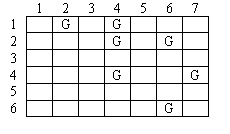Robots(Poj1548)(贪心)
2016-01-01 16:44
393 查看
Robots
Description
Your company provides robots that can be used to pick up litter from fields after sporting events and concerts. Before robots are assigned to a job, an aerial photograph of the field is marked with a grid. Each location in the grid that contains garbage is
marked. All robots begin in the Northwest corner and end their movement in the Southeast corner. A robot can only move in two directions, either to the East or South. Upon entering a cell that contains garbage, the robot will pick it up before proceeding.
Once a robot reaches its destination at the Southeast corner it cannot be repositioned or reused. Since your expenses are directly proportional to the number of robots used for a particular job, you are interested in finding the minimum number of robots that
can clean a given field. For example, consider the field map shown in Figure 1 with rows and columns numbered as shown and garbage locations marked with a 'G'. In this scheme, all robots will begin in location 1,1 and end in location 6, 7.

Figure 1 - A Field Map
Figure 2 below shows two possible solutions, the second of which is preferable since it uses two robots rather than three.

Figure 2 - Two Possible Solutions
Your task is to create a program that will determine the minimum number of robots needed to pick up all the garbage from a field.
Input
The input consists of one or more field maps followed by a line containing -1 -1 to signal the end of the input data. A field map consists of one or more lines, each containing one garbage location, followed by a line containing 0 0 to signal the end of the
map. Each garbage location consists of two integers, the row and column, separated by a single space. The rows and columns are numbered as shown in Figure 1. The garbage locations will be given in row-major order. No single field map will have more than 24
rows and 24 columns. The sample input below shows an input file with two field maps. The first is the field map from Figure 1.
Output
The output will consist of a single line for each field map containing the minimum number of robots needed to clean the corresponding field.
Sample Input
Sample Output
Source
Mid-Central USA 2003
数组开大点,不然一直RE。 思路:只要右边有垃圾就往右走,没有就往下走~
| Time Limit: 1000MS | Memory Limit: 10000K | |
| Total Submissions: 4080 | Accepted: 1870 |
Your company provides robots that can be used to pick up litter from fields after sporting events and concerts. Before robots are assigned to a job, an aerial photograph of the field is marked with a grid. Each location in the grid that contains garbage is
marked. All robots begin in the Northwest corner and end their movement in the Southeast corner. A robot can only move in two directions, either to the East or South. Upon entering a cell that contains garbage, the robot will pick it up before proceeding.
Once a robot reaches its destination at the Southeast corner it cannot be repositioned or reused. Since your expenses are directly proportional to the number of robots used for a particular job, you are interested in finding the minimum number of robots that
can clean a given field. For example, consider the field map shown in Figure 1 with rows and columns numbered as shown and garbage locations marked with a 'G'. In this scheme, all robots will begin in location 1,1 and end in location 6, 7.

Figure 1 - A Field Map
Figure 2 below shows two possible solutions, the second of which is preferable since it uses two robots rather than three.

Figure 2 - Two Possible Solutions
Your task is to create a program that will determine the minimum number of robots needed to pick up all the garbage from a field.
Input
The input consists of one or more field maps followed by a line containing -1 -1 to signal the end of the input data. A field map consists of one or more lines, each containing one garbage location, followed by a line containing 0 0 to signal the end of the
map. Each garbage location consists of two integers, the row and column, separated by a single space. The rows and columns are numbered as shown in Figure 1. The garbage locations will be given in row-major order. No single field map will have more than 24
rows and 24 columns. The sample input below shows an input file with two field maps. The first is the field map from Figure 1.
Output
The output will consist of a single line for each field map containing the minimum number of robots needed to clean the corresponding field.
Sample Input
1 2 1 4 2 4 2 6 4 4 4 7 6 6 0 0 1 1 2 2 4 4 0 0 -1 -1
Sample Output
2 1
Source
Mid-Central USA 2003
数组开大点,不然一直RE。 思路:只要右边有垃圾就往右走,没有就往下走~
#include<stdio.h>
#include<string.h>
#include<algorithm>
using namespace std;
struct st
{
int l,r,flag;
}s[1000];
int cmp(st x,st y)
{
if(x.l!=y.l)
return x.l<y.l;
return x.r<y.r;
}
int main()
{
int i,j,a,b,n,ans;
while(scanf("%d%d",&a,&b)&&(a!=-1&&b!=-1))
{
ans=i=0;
while(a&&b)
{
s[i].l=a;
s[i].r=b;
s[i].flag=0;
scanf("%d%d",&a,&b);
i++;
}
n=i;
sort(s,s+n,cmp);
for(i=0;i<n;i++)
{
if(!s[i].flag)
{
s[i].flag=1;
ans++;
a=s[i].r;
for(j=i+1;j<n;j++)
{
if(!s[j].flag&&s[j].r>=a)
{
s[j].flag=1;
a=s[j].r;
}
}
}
}
printf("%d\n",ans);
}
}
相关文章推荐
- 懵懵懂懂初识J2EE
- Apache日志切割
- Qt 中设置窗体透明度的几种方法
- java调用shell命令并获取执行结果
- 电话拨号前加上ip号码(广播)
- Android ListView控件使用
- MYECLIIPSE编码问题
- .NET学习(十)listbox使用时注意
- Linux关于总线、设备、驱动的注册顺序
- Android之传感器系统
- 子序列和问题
- C#设计模式_单例模式
- python学习(一)变量和数据类型
- 如何一步步拿到伐册 book申请http://www.bosshr.com/shownews_47767.html
- 网站架构知识系列-架构要素
- 进程相关命令的使用
- 15年摄像头传感器
- ng
- gcc 编译.c文件的编译过程
- 最常用的20个监控Linux系统性能的命令行工具
